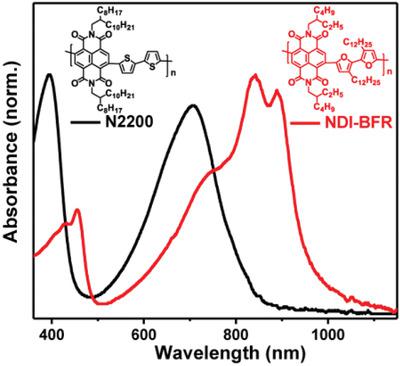当前位置:
X-MOL 学术
›
Macromol. Rapid Commun.
›
论文详情
Our official English website, www.x-mol.net, welcomes your
feedback! (Note: you will need to create a separate account there.)
Ultranarrow Bandgap Naphthalenediimide-Dialkylbifuran-Based Copolymers with High-Performance Organic Thin-Film Transistors and All-Polymer Solar Cells.
Macromolecular Rapid Communications ( IF 4.2 ) Pub Date : 2020-05-13 , DOI: 10.1002/marc.202000144 Shengbin Shi 1, 2 , Peng Chen 2 , Hang Wang 2 , Chang Woo Koh 3 , Mohammad Afsar Uddin 4 , Bin Liu 2 , Qiaogan Liao 1 , Kui Feng 2 , Han Young Woo 3 , Guomin Xiao 1 , Xugang Guo 2
Macromolecular Rapid Communications ( IF 4.2 ) Pub Date : 2020-05-13 , DOI: 10.1002/marc.202000144 Shengbin Shi 1, 2 , Peng Chen 2 , Hang Wang 2 , Chang Woo Koh 3 , Mohammad Afsar Uddin 4 , Bin Liu 2 , Qiaogan Liao 1 , Kui Feng 2 , Han Young Woo 3 , Guomin Xiao 1 , Xugang Guo 2
Affiliation

|
A new polymer acceptor poly{(N ,N′‐bis(2‐ethylhexyl)‐1,4,5,8‐naphthalenedicarboximide‐2,6‐diyl)‐alt ‐5,5‐(3,3′‐didodecyl‐2,2′‐bifuran)} (NDI‐BFR) made from naphthalenediimide (NDI) and furan‐derived head‐to‐head‐linked 3,3′‐dialkyl‐2,2′‐bifuran (BFR) units is reported in this study. Compared to the benchmark polymer poly(naphthalenediimide‐alt ‐bithiophene) (N2200), NDI‐BFR exhibits a larger bathochromic shift of absorption maxima (842 nm) with a much higher absorption coefficient (7.2 × 104 m −1 cm−1), leading to an ultranarrow optical bandgap of 1.26 eV. Such properties ensure good harvesting of solar light from visible to the near‐infrared region in solar cells. Density functional theory calculation reveals that the polymer acceptor NDI‐BFR possesses a higher degree of backbone planarity versus the polymer N2200. The polymer NDI‐BFR exhibits a decent electron mobility of 0.45 cm2 V−1 s−1 in organic thin‐film transistors (OTFTs), and NDI‐BFR‐based all‐polymer solar cells (all‐PSCs) achieve a power conversion efficiency (PCE) of 4.39% with a very small energy loss of 0.45 eV by using the environmentally friendly solvent 1,2,4‐trimethylbenzene. These results demonstrate that incorporating head‐to‐head‐linked BFR units in the polymer backbone can lead to increased planarity of the polymer backbone, reduced optical bandgap, and improved light absorbing. The study offers useful guidelines for constructing n‐type polymers with narrow optical bandgaps.
中文翻译:

具有高性能有机薄膜晶体管和全聚合物太阳能电池的超窄带隙萘二酰亚胺-二烷基联呋喃基共聚物。
一种新的聚合物受体聚{(Ñ,N'-双(2-乙基己基)-1,4,5,8-萘二酰亚胺-2,6-二基) - ALT -5,5-(3,3'- didodecyl-据报道,由萘二酰亚胺(NDI)和呋喃衍生的头对头连接的3,3'-二烷基-2,2'-二呋喃(BFR)单元制成的2,2'-二呋喃)}(NDI-BFR)这项研究。相比于基准聚合物聚(naphthalenediimide- ALT联噻吩)(N2200),NDI-BFR表现出最大吸收值(842纳米)具有高得多的吸收系数(7.2×10较大的红移4 米-1厘米-1),导致1.26 eV的超窄光学带隙。这些特性可确保从可见光到太阳能电池中的近红外区域都能很好地收集太阳光。密度泛函理论计算表明,与聚合物N2200相比,聚合物受体NDI-BFR具有更高的骨架平面度。聚合物NDI-BFR具有0.45 cm 2 V -1 s -1的体面电子迁移率在有机薄膜晶体管(OTFT)和基于NDI-BFR的全聚合物太阳能电池(all-PSC)中,通过使用环保材料,可实现4.39%的功率转换效率(PCE),且只有0.45 eV的很小的能量损耗友好溶剂1,2,4-三甲基苯。这些结果表明,将头对头连接的BFR单元并入聚合物主链中可导致聚合物主链的平面度增加,光学带隙减小和光吸收改善。该研究为构建具有窄光学带隙的n型聚合物提供了有用的指导。
更新日期:2020-06-18
中文翻译:

具有高性能有机薄膜晶体管和全聚合物太阳能电池的超窄带隙萘二酰亚胺-二烷基联呋喃基共聚物。
一种新的聚合物受体聚{(Ñ,N'-双(2-乙基己基)-1,4,5,8-萘二酰亚胺-2,6-二基) - ALT -5,5-(3,3'- didodecyl-据报道,由萘二酰亚胺(NDI)和呋喃衍生的头对头连接的3,3'-二烷基-2,2'-二呋喃(BFR)单元制成的2,2'-二呋喃)}(NDI-BFR)这项研究。相比于基准聚合物聚(naphthalenediimide- ALT联噻吩)(N2200),NDI-BFR表现出最大吸收值(842纳米)具有高得多的吸收系数(7.2×10较大的红移4 米-1厘米-1),导致1.26 eV的超窄光学带隙。这些特性可确保从可见光到太阳能电池中的近红外区域都能很好地收集太阳光。密度泛函理论计算表明,与聚合物N2200相比,聚合物受体NDI-BFR具有更高的骨架平面度。聚合物NDI-BFR具有0.45 cm 2 V -1 s -1的体面电子迁移率在有机薄膜晶体管(OTFT)和基于NDI-BFR的全聚合物太阳能电池(all-PSC)中,通过使用环保材料,可实现4.39%的功率转换效率(PCE),且只有0.45 eV的很小的能量损耗友好溶剂1,2,4-三甲基苯。这些结果表明,将头对头连接的BFR单元并入聚合物主链中可导致聚合物主链的平面度增加,光学带隙减小和光吸收改善。该研究为构建具有窄光学带隙的n型聚合物提供了有用的指导。











































 京公网安备 11010802027423号
京公网安备 11010802027423号